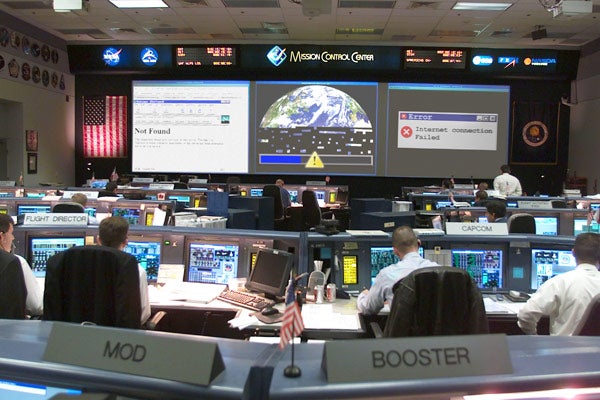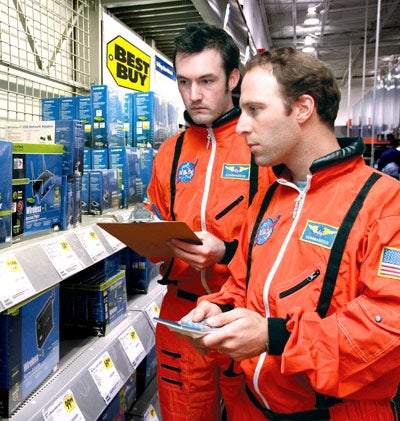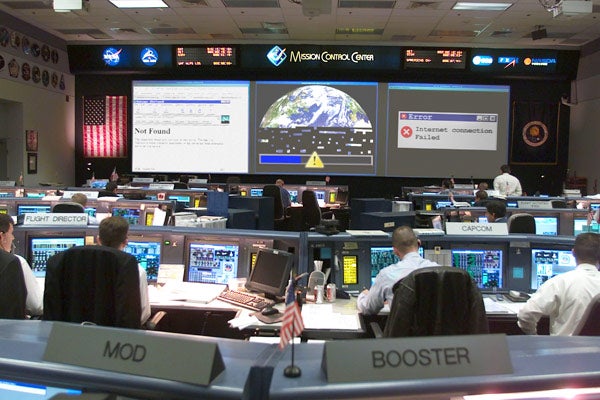HOUSTON—NASA administrator Michael Griffin announced during a press conference Tuesday that the space agency is launching an ambitious mission to make Houston’s Johnson Space Center wireless-Internet capable within one decade.

“We are entering a new era for NASA,” Griffin said during a slide show for reporters showing conceptual illustrations of a wireless modem that would be used in all of the agency’s offices and laboratories that use personal computers. “We are not content to rest on our laurels. It may seem like an impossible task, but if we commit all of our focus, technology, and resources, we can get Wi-Fi into NASA’s offices and research labs within our generation.”
Griffin was confident that NASA’s estimated $655 million plan to install a wireless broadband router by 2017 could reap huge benefits for the entire space agency.
“In a few short years, all NASA employees will be able to check their e-mail throughout the complex, even in the cafeteria,” Griffin said.
According to agency officials, accessing the Internet has been an ongoing struggle for NASA. Still relying on a single dial-up modem, employees nevertheless continue to get disconnected from the Internet whenever the Johnson Space Center receives an incoming call or someone picks up the phone to dial out. In 2005, NASA attempted to upgrade from dial-up to DSL, but the program was aborted when engineers were unable to get the Ethernet hub to function.
While the building that houses the public affairs office can currently pick up a weak Wi-Fi signal from a Starbucks across the street, the Johnson Space Center as a whole is far from being the “giant Wi-Fi hotspot” Griffin envisions.
“If NASA is to fulfill its vision of a working environment of today, we will need to develop existing technologies to ensure Internet connectivity can be sustained without employees becoming entangled in cords,” Griffin said.

If federal funding is approved, NASA will begin its search for wireless capability by sending a series of robotic probes into the depths of the Johnson Space Center, exploring the surfaces of desks and tables to search for the most viable modem base. Once the probes have photographed the area, the information they have gathered will be transmitted back to Houston’s Mission Control Center for analysis.
Griffin said that the agency has also recruited seven information technology specialists from some of the nation’s top white-collar regional workplaces. The seven mission specialists in the newly dubbed “Internet Explorer” program are being rigorously trained to install the theoretical wireless devices in an Earth-gravity environment in which they could encounter potentially arduous conditions such as poor air ventilation and lifeless workscapes.
Since spring, NASA has also conducted some preliminary, small-scale reconnaissance missions to a Houston-area Best Buy, where crews conducted research and compared prices. Scientists within the agency say early data from the trips is promising, showing a generous return policy and an extended warranty plan. In addition, researchers have investigated the digital cable setup at veteran space shuttle astronaut Ken Bowersox’s house.
NASA has suffered from a public credibility crisis in recent years due to perceived incompetence, a failed mission to Mars, the damaged and dormant Hubble telescope, and its inability to procure a long enough USB cable to reach all the way over to engineer William Chen’s cubicle. But NASA officials argue that a secure high-speed line could prevent disasters such as a 2005 incident in which an employee attempting to download the movie trailer for Cheaper by the Dozen 2 crashed the Mission Control Center mainframe computer for two weeks.
Griffin may have an uphill battle convincing Congress to fund the project. As the NASA administrator himself admitted at the press conference, even if a workable wireless router is successfully purchased, engineers will need at least an additional two years to examine the owner’s manual before attempting to install the complicated equipment.
Once the wireless local area network is completed, Griffin said that NASA will embark on its next great project: constructing a laptop capable of taking advantage of Wi-Fi’s high-speed access by 2037.







